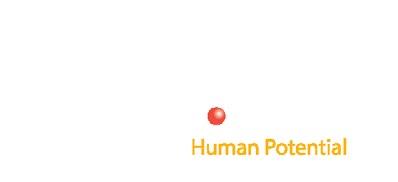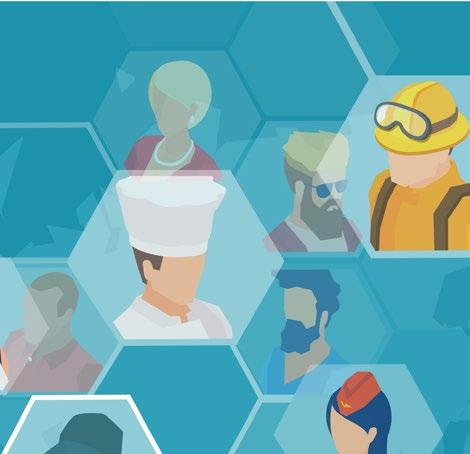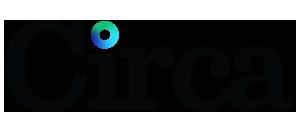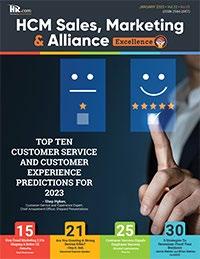

MAY 2023 • Vol.11 • No.05 (ISSN 2564-1964) 22 12 28 33 Clean The Fish Tank Before You Add More Fish - Joanne Lockwood, SEE Change Happen The State Of Pre-Hiring Tools And Assessment - Anil Lanba, Pyramid IT Consulting Pvt. Ltd. The False Promises Of AI Recruitment - Nancy Drees, Vacaré Group Getting Past Vanity Metrics To Track Hiring Numbers That Count - Matt Parkin, FindWRK AI AND CHATGPT: REVOLUTIONIZING RECRUITMENT OR A RISKY BUSINESS? - Evan Shellshear, Managing Director and Group CEO, Ubidy
On the Cover
Articles
09 Four Ways To Address The Industry’s Technician Shortage Insights and actionable steps to tackle the growing technician shortage in equipment manufacturing
- Julie Davis, Sr. Director of Workforce & Industry Initiatives, Association of Equipment Manufacturers
16 7 Ways To Determine Candidate Culture Fit (Besides Interview Assessments)
Evaluating candidates the right way
- Brett Farmiloe, Founder and CEO, Terkel
26 Empowering Neurodiverse Talent For Business Success
Breaking barriers and embracing diversity
- Martin McKay, CEO and Founder, Texthelp
AI And ChatGPT: Revolutionizing Recruitment Or A Risky Business?
From streamlining HR processes to replacing humans altogether, learn how AI will impact recruitment

- Evan Shellshear, Managing Director and Group CEO, Ubidy
30 3 Considerations For Cybersecurity Leaders In 2023
Building a cyber-smart organization; empowering employees for cybersecurity vigilance
- Jim Chilton, Chief Technology Officer, Cengage Group
35 Leveraging ChatGPT As An Interviewer Or Candidate
Elevating the interview experience for interviewers and candidates
- Chris Murdock, Chief Sourcing Officer and Co-Founder, IQTalent
39 Enhancing The Workplace With Neurodiversity
How to create an employee experience that empowers everyone
- Sarah Danzl, VP of Client Marketing and Communications, Degreed
07
Talent Acquisition Excellence MAY 2023 Vol.11 No.05
(ISSN 2564-1964) INDEX
Clean The Fish Tank Before You Add More Fish
Prioritizing employee well-being and inclusion


- Joanne Lockwood, Inclusive Culture Expert, SEE Change Happen
The State Of Pre-Hiring Tools And Assessment

What is the need and what are the tools for success?
The False Promises Of AI Recruitment



Can AI measure culture fit?
- Nancy Drees, Founder & CEO, Vacaré Group
Top Picks 12 22 28 33
Getting Past Vanity Metrics To Track Hiring Numbers That Count
Are you tracking the right recruiting numbers for your business?
- Matt Parkin, Business Development Lead, FindWRK
- Anil Lanba, Executive Vice President, Pyramid IT Consulting Pvt. Ltd.
INDEX
Editorial Purpose
Our mission is to promote personal and professional development based on constructive values, sound ethics, and timeless principles.
Excellence Publications
Debbie McGrath CEO, HR.com - Publisher
Dawn Jeffers VP, Sales

Sue Kelley Director (Product, Marketing, and Research)
Babitha Balakrishnan and Deepa Damodaran Excellence Publications Managers and Editors
Talent Acquisition Excellence Team
Deepa Damodaran Editor

Koushik Bharadhwaj Junior Editor
Nataraj Ramesh Design and Layout (Digital Magazine)
Chandra Shekar Magazine (Online Version)
Submissions & Correspondence
Please send any correspondence, articles, letters to the editor, and requests to reprint, republish, or excerpt articles to ePubEditors@hr.com
For customer service, or information on products and services, call 1-877-472-6648
For Advertising Opportunities, email: sales@hr.com
Talent Acquisition Excellence (ISSN 2564-1964)
Debbie Mcgrath Publisher, HR.com
The Future of Recruitment in the Era of AI
Artificial Intelligence (AI) has been a hot topic in recruitment for years, and the recent public launch of ChatGPT has only intensified the conversation.
CNBC and other media outlets are highlighting the potential of AI to revolutionize the recruitment and retention experience, leading numerous companies to partner with AI recruitment firms in an effort to streamline and optimize their hiring processes.
While AI offers exciting possibilities, like any new technology, it also comes with inherent risks.
How will AI and ChatGPT impact recruitment? Is there a possibility that AI might limit human involvement and restrict a company's hiring and recruitment strategies? Moreover, could AI inadvertently reinforce unconscious biases and undermine the progress made in achieving fair and unbiased recruitment practices?
In this edition, we feature Dr. Evan Shellshear, MD and Group CEO of Ubidy, who explores the transformative potential of AI and ChatGPT in recruitment in his article AI And ChatGPT: Revolutionizing Recruitment Or A Risky Business?
Additionally, Nancy Drees, Founder & CEO of Vacaré Group, challenges the notion of whether AI can accurately measure culture fit in her opinion piece The False Promises Of AI Recruitment.
Finding suitable candidates for vacant positions is possibly one of the most underrated and tedious tasks in an
Deepa Damodaran Editor, Talent Acquisition Excellence
organization. And, with the global talent and skill shortages looming over almost all industries, the job of recruitment, talent acquisition, and human resource teams has become even more challenging. Getting the right employee requires an “N” number of calls, tests, and of course, a pre-hiring assessment.
Check out The State Of Pre-Hiring Tools And Assessment, where Anil Lanba, Executive Vice President of Pyramid IT Consulting, goes in-depth into the topic and explores how pre-hire tools help talent acquisition professionals achieve success in their hiring and recruitment efforts. He also touches upon the drawbacks of the processes.
Also, read Clean The Fish Tank Before You Add More Fish by Joanne Lockwood, an Inclusive Culture Expert at SEE Change Happen, and 7 Ways To Determine Candidate Culture Fit (Besides Interview Assessments) by Brett Farmiloe, Founder and CEO of Terkel. These articles offer valuable insights into assessing culture fit and avoiding potential pitfalls in the recruitment process.
We hope this edition of Talent Acquisition Excellence will help you understand the impact of AI on recruitment and engage in a critical discussion about the benefits, challenges, and ethical considerations surrounding this evolving technology.
Happy Reading!
is published monthly by HR.com Limited, 56 Malone Road, Jacksons Point, Ontario L0E 1L0
Address: www.hr.com
The views, information, or opinions expressed in the Excellence ePublications
solely those of the authors and do not necessarily represent those of HR.com and its
no circumstances shall HR.com or its partners or affiliates be responsible
liable for any indirect or incidental damages arising out of these opinions and content. EDITOR’S
Internet
Disclaimer:
are
employees. Under
or
NOTE
Become a Member Today to get it FREE!
Write to the Editor at ePubEditors@hr.com OR Subscribe now for $99 / year And get this magazine delivered to your inbox every month SIGN UP
How are our Talent Acquisition Products and Services helping to make you smarter?


Talent Acquisition Excellence - Monthly Interactive Learning Journal
This monthly interactive learning experience captures key metrics, actionable items and keeps you focused on developing yourself and corporation as top leaders in the Talent Acquisition space.
Talent Acquisition Virtual Events

Talent Acquisition Virtual Events offer webcasts and demos on topics in any of the staffing related programs: Contract Workforce and Talent Exchanges, Online Staffing and Sourcing, Recruitment Process Outsourcing, or Quality of Hire. Learn how to bring the right staffing and recruiting programs into your organization and make them impactful. Listen to the world’s top thought leaders in the staffing industry as they help companies make decisions in all areas of staffing and recruiting. Each Virtual Event consists of up to 10 credit webcasts.
Talent Acquisition Webcasts for Credit
HR.com webcasts deliver the latest Talent Acquisition industry news, research trends, best practices and case studies directly to your desktop. Webcasts are available live online with a downloadable podcast and a copy of the slides (PDF) available before and after each webcast. Earn all of the required recertification credits for aPHR, PHR, SPHR, GPHR, and SHRM Certifications. HR.com’s one-hour webcasts, in every HR specialty including Talent Acquisition, are pre-approved for HRCI and SHRM credit (excluding Demo webcasts).
Talent Acquisition Community
Join almost 55,000 HR.com members with a similar interest and focus on staffing and recruiting topics with one of the four staffing related online communities: Contract Workforce and Talent Exchanges, Online Staffing and Sourcing, Recruitment Process Outsourcing, or Quality of Hire. Share content and download research reports, blogs, and articles, network, and “follow” peers and have them “follow” you in a social network platform to communicate regularly and stay on top of the latest updates. This well established Community is an invaluable resource for any HR professional or manager.
Use these invaluable Talent Acquisition resources today! For more information phone: 1.877.472.6648 | email: sales@hr.com | www.hr.com
AI And ChatGPT: Revolutionizing Recruitment Or A Risky Business?
From streamlining HR processes to replacing humans altogether, learn how AI will impact recruitment
By Evan Shellshear, Ubidy
Artificial intelligence (AI) and ChatGPT have been transforming industries across the board. In the world of recruitment, the potential benefits of AI and ChatGPT are hard to ignore: streamlining human
resources (HR) processes, automating repetitive tasks, and increasing efficiency.

Submit Your Articles Talent Acquisition Excellence presented by HR.com MAY 2023 6
COVER ARTICLE
However, as with any new technology, there are also risks associated with their use. How will AI and ChatGPT impact recruitment? Could AI limit a company’s hiring and recruitment strategy by limiting human intervention? Could AI be exacerbating unconscious bias and reversing decades of progress in fair recruitment?
In this article, we explore these questions and more.
One of the most significant benefits of AI and ChatGPT in recruitment is the ability to automate repetitive tasks, such as job description creation and grading resumes. This not only saves HR professionals valuable time but also helps to reduce the potential for some types of human biases. In addition, AI can help identify top candidates more efficiently by analyzing large amounts of text data,
such as cover letters and CVs, and matching them with job requirements.
However, the use of AI in recruitment is not without risks. One of the most significant concerns is the potential for unconscious bias. AI algorithms are only as unbiased as the data used to train them, and if the data is biased, the results will be too. For example, if an AI algorithm is trained on data that predominantly consists of male candidates, it may be more likely to favor male candidates in the recruitment process.
HR teams need to ensure that the data used to train AI algorithms is diverse and unbiased to minimize the risk of unconscious bias. Therefore, when leveraging tools like ChatGPT to augment your recruitment, you will be subjecting the process to the unknown biases contained within the tool.

AI
Business? Submit Your Articles Talent Acquisition Excellence presented by HR.com MAY 2023 7
And ChatGPT: Revolutionizing Recruitment Or A Risky
And ChatGPT: Revolutionizing Recruitment Or A Risky Business?
Some of the best applications of AI go beyond natural language processing and large language models, such as ChatGPT, and avoid the bias challenges by focusing on the smarter and more efficient connection of recruitment agencies to employers. Modern platforms, such as recruitment agency marketplaces, use AI to connect recruiters to organizations but then allow humans to do what they do best - reading the unspoken indications of candidate quality discovered during a face-to-face meeting.
Another concern with the use of AI in recruitment is the potential for it to limit human intervention. While AI can be extremely useful in identifying top candidates, it is still important for HR professionals to make the final decision. AI cannot replace the important soft skills and intuition that HR professionals bring to the recruitment process. HR teams need to use AI to augment, rather than replace, human decision-making.
Despite these risks, many experts believe that AI and ChatGPT have the potential to revolutionize recruitment. One example is the use of ChatGPT in the recruitment process. ChatGPT is a type of AI technology that can engage in natural language conversations with candidates, providing them with information about the company and the recruitment process, as well as answering their questions.
This can help to improve the candidate experience (for example, recent studies showed that AI systems had better bedside manners than doctors, including more patience and empathy) and reduce the workload of HR professionals.However, the use of AI and ChatGPT in recruitment is subject to controversy. Some people worry that it could lead to a future in which HR professionals are replaced by machines altogether. While this may be a concern for some, it is important to remember that AI is only as good as the data used to train it. As such, it is unlikely that AI will completely replace HR professionals in the near future - especially when assessing human characteristics for which we have no data to train an AI.
So, how can HR teams mitigate the risks associated with the use of AI and ChatGPT in recruitment?
Firstly, they need to ensure that the data used to train AI algorithms is diverse and unbiased. Secondly, they should use AI to augment, rather than replace, human decision-making. Finally, they need to be transparent about their use of AI in the recruitment process, so that candidates are comfortable with its use and HR teams can build trust with them.

AI and ChatGPT have the potential to revolutionize recruitment by automating repetitive tasks and streamlining HR processes. However, there are risks associated with their use, including the potential for unconscious bias and the limitation of human intervention. HR teams need to take steps to mitigate these risks by ensuring that AI is used to augment, rather than replace, human decision-making, and by being transparent about their use of AI in the recruitment process.
Recommended Resources:
● GPT-3: The Ultimate Guide To Building NLP Products With OpenAI API.
● People Analytics in the Age of Big Data
Dr. Evan Shellshear is the Managing Director and Group CEO of Ubidy and an expert in artificial intelligence with a Ph.D. in Game Theory from the Nobel Prize-winning University of Bielefeld in Germany. He has almost two decades of international experience in the development and design of AI tools for a variety of industries having worked with the world’s top companies on all aspects of advanced analytical solutions from optimization to machine learning in applications from HR to oil and gas, and robotics to supply chain. He is also the author of the Amazon best-seller, ‘Innovation Tools’.
Would you like to comment?
AI
Submit Your Articles Talent Acquisition Excellence presented by HR.com MAY 2023 8
Four Ways To Address The Industry’s Technician Shortage
Insights and actionable steps to tackle the growing technician shortage in equipment manufacturing
 By Julie Davis, Association of Equipment Manufacturers
By Julie Davis, Association of Equipment Manufacturers
According to a 2020 AED Foundation industry research report, our industry may need to fill as many as 73,500 heavy equipment technician positions by 2025. In addition, the report stated equipment manufacturing possesses a job opening
rate three times higher than the national average. Among survey respondents, 95% agreed with the assertion there was a skills gap in the industry, while 89% reported a shortage of workers within the walls of their respective companies.
It is no secret to anyone working in equipment manufacturing that the ever-growing technician shortage is a problem poised to get a lot worse before it gets better.
Submit Your Articles Talent Acquisition Excellence presented by HR.com MAY 2023 9
Now, I do not want to suggest the widespread technician shortage can be quickly addressed, let alone easily solved. However, equipment manufacturers can (and should) embrace and adopt several short-term and long-term strategies to set themselves up for sustained success as it relates to workforce development.

Let us examine four in detail:
1. Focus on Retention
So many pieces of the technician workforce puzzle can only be lightly influenced. However, one area companies can focus their efforts on to drive positive change, as it relates to retention, is workplace culture. Start by asking the following two questions:
● Are exit interviews being conducted?
Technicians leaving an organization within the first six months could indicate an onboarding problem, while technicians leaving between 2.5 and 3.5 years could indicate a lack of development opportunities. With exit interviews, it is worthwhile to have both a manager and human resources representative conduct interviews separately, as each position is likely to elicit different responses from departing employees.
● Are staying interviews being conducted?
Talking with staff in key positions about their individual experiences
can shed light on missed opportunities or future red flags. Engaging in staying interviews can be particularly helpful in the first 12 months to understand what it is like to be onboarded and how new employees experience the existing culture within the organization. Start by creating a culture check-in by surveying all employees. What changes can be made based on all the information learned? And remember, to those companies who are not currently acting on employee feedback being received, asking for additional input can (and likely will) negatively impact culture moving forward.
Four Ways To Address The Industry’s Technician Shortage
Submit Your Articles Talent Acquisition Excellence presented by HR.com MAY 2023 10
2. Fill the Talent Pipeline
There is no overstating the importance of finding ways to fill an organizational talent pipeline. And while it takes time to secure a return on investments of time, effort and resources to do so, it is worth it to take proactive steps to ensure desired results.
Simply contacting the nearest local technical college once or twice a year is not going to be enough to attract and acquire talent. Regularly engage with educational institutions. Be a part of review committees. Get in front of students in classrooms. Donate equipment. More than anything else, do what it takes to be top of mind when these schools begin looking to place their best students. It will pay dividends over time.
In addition, it is important to connect with high schools feeding into technical college programs. One effective way to do so is to introduce the high schools to a free, high school technician curriculum. It should just not be any technician curriculum but rather a program that introduces the technician career to a wide audience and enhances industry perception to parents, teachers, and students.
Organizations must be willing to shed light on the significant industry demand for qualified workers and worthwhile career opportunities because chances are they are not aware of the extent of the existing technician shortage. Technician program
partnerships, apprenticeships, job shadowing or any other work-and-learn program are the most effective way to connect with new workers. And, ultimately, partnering with education is critical for retention, as technicians require ongoing training and development.
of workers the organization wants to replicate might be out and see if the openings can be posted.
● Learn more by reading Equipment World’s 27 Ways to Attract and Retain Equipment Technician Talent and Chris Czarnik’s Winning the War for Talent
4. Collaborate with Others
When it comes to understanding the work being done to support the industry’s needs in this space, many associations are trying to collaborate rather than duplicate efforts. Just as there is no one thing that a company can do to help ease the technician shortage, there is no one associate that can solve the challenge on their own.

3. Diversify and Optimize Recruitment Strategies
Want to move the needle when it comes to acquiring talent? Do the following:
● Actively recruit women and minorities.
● Change the way job postings are written and where they are being posted.
● Check language in job postings via a gender decoder website to determine if it is overly masculine.
● Target locations and events where someone with the skills, interests, and hobbies
Would you like to comment?
Julie Davis is the Sr. Director of Workforce & Industry Initiatives at the Association of Equipment Manufacturers (AEM). She currently works to support workforce development for the construction, agriculture and utility industry sectors.
Four Ways To Address The Industry’s Technician Shortage
Submit Your Articles Talent Acquisition Excellence presented by HR.com MAY 2023 11
Equipment manufacturing possesses a job opening rate three times higher than the national average
Clean The Fish Tank Before You Add More Fish
Prioritizing employee well-being and inclusion
By Joanne Lockwood, SEE Change Happen
TheGreat Resignation and Quiet Quitting signaled a change in employment as a worker’s market, and employees increasingly sought to meet their own personal requirements and align themselves with an organization’s values and purpose. Congruently, organizations have rightly been focused on diversity hiring initiatives, but so much so that many are not looking at how their existing employees are experiencing the workplace. We need to clean the toxic tank before we bring in new fish, or both the existing and new fish will fail to thrive.
A toxic work environment usually becomes clearly apparent through the extremes of harassment and bullying, but discrimination alone can result in high employee turnover and unproductive, demoralized employees, with three in five employees in a survey saying
work-related stress led to a lack of interest, motivation and energy at work.
Toxic work environments also have a significant impact on
mental and physical health, with work-related stress resulting in 32% of respondents reporting emotional exhaustion, and 44% reporting physical fatigue.
Top Pick Submit Your Articles Talent Acquisition Excellence presented by HR.com MAY 2023 12
The lack of diversity and inclusion results in poor work cultures. I was at a Royal Air Force (RAF) reunion recently, and we were a mixed bunch from diverse backgrounds and ethnicities, but the group was predominantly straight, white, and male. There were conversations vociferously rejecting the phrase “white privilege” and defending the “white male” as an under-attack group – one friend remarked that he may be white and male, but he had not had it easy. Of course, he had not had it easy, but checking one’s privilege is not about comparing the struggles you have had with those of others – it is about recognizing the struggles you have not had to experience because of your gender, skin color and sexual orientation.
I was speaking to a young graduate black woman, who had joined her organization through a graduate entry scheme. Many of her fellow graduates were also young black or brown women, so she felt there was an opportunity to progress in an organization committed to its diversity and inclusion values. Her hopes and those of others in her program were soon dashed – a promotion
was offered behind the scenes to a white woman from the group.
Given the opportunity was not advertised, the black and brown graduates were not even aware of what had happened until it was a fait accompli. Another woman shared a story about her black colleague, who was dismissed without any warning due to poor work performance. On investigation, it transpired that the supervisor was too afraid to discuss their performance and coach them because they were worried it would be seen as racist and ignored the issue until it became an insurmountable problem.
These examples are everywhere when talking to people from marginalized or under-represented groups. The lived experience bears out the truth that we are a long way from leveling up the playing field. A toxic work environment is contagious. Even a hybrid workplace can be noxious as toxicity can spread just as easily virtually as it can in person. This means that businesses need to be more focused on retaining before looking at onboarding
and attracting new talent and recruiting.
The first port of call must be to identify the sources of toxicity and address problem behaviors by directly addressing discrimination and harassment and developing a zero-tolerance policy which will at the same time build transparency and trust. Creating a safe space with a confidential system in place to enable employees to report any incidents of toxicity or harassment is a must, as is offering mental health support and resources to those who may be struggling. Companies that have effective channels of communication usually have around a 50% higher chance of reducing employee turnover.
But there are also deeper ways to clean the tank and clean out the toxicity in business culture. Here are ten further solutions.
1. Actively and authentically choose diversity, equality and inclusion to avoid workers feeling disrespected and undervalued, and to break the cycle of toxicity, bullying, discrimination, lack of support, poor communication and high turnover. It is easy to fall into the echo chamber, where everyone has similar thoughts and beliefs about building an equitable society and workplace, but no actions change. Diversity and inclusion will lead to greater innovation and collaboration in the workplace, ultimately benefiting businesses and individuals.

Clean The Fish Tank Before You Add More Fish
Submit Your Articles Talent Acquisition Excellence presented by HR.com MAY 2023 13
2. Create a culture that employees want to be part of. Changing the work culture from within and retaining current employees is more financially beneficial than continuing to hire new employees, which can cost companies an average of £30,000. To have an attractive, healthy culture, check your current employees’ experience – how is their well-being, what are their opportunities for development, and are they under too much pressure?
3. Offer a wage to match the hard work of your employees and to make them feel valued. Pay them what their time, experience, responsibility and knowledge are worth. Do not cut corners, and make sure there is true equity. If their responsibility increases, so should their pay, and they should be able to afford the cost of living. If you are not matching the salaries that your competitors are offering, then that will result in an exodus of talent. Recognize and reward your employees and understand that means different things to different people.
4. Prioritize wellness to enable employees to have a good work/ life balance to reduce work-related stresses and tensions or conflict in the workplace. Culling toxicity needs to be a priority to ensure employee wellness and to reduce any potential for burnout or high employee turnover. Work stress and burnout often come from a lack of support, too much pressure, too great a workload,
poor communication and unreasonable demands.
5. Encourage teamwork. When we feel we are all in it together and have opportunities to collaborate and use our skills to good effect, strong relationships are likely to be built. This is also a good way to identify potential problem employees who will not cooperate.
6. Upskill your existing talent. The value of continuing to invest in training and upskilling employees can sometimes be forgotten, with many managers moving straight to employing externally. Enabling employees to develop their skills and enhance their expertise means they can grow and learn and continue to feel engaged and motivated at work.
7. Don’t force employees to participate. Forced participation in work projects, such as presentations, or social or team-building activities, can be big enough for some people to want to leave. Know your people and offer choices, and develop employee engagement in other ways.
8. Be flexible. Offer flexible work arrangements to accommodate employee needs to ensure their well-being. Workers with better flexibility enjoy greater autonomy and feel less fatigue as a result of lengthy commutes and less stress about childcare. Reduce non-essential meetings (in person and online).
9. Feedback opportunities – Fostering a supportive management style with feedback opportunities for both listening and giving feedback can create a more open workplace culture. Twenty-five percent reported in one survey that they do not feel safe voicing their onions on work-related issues, such as communication and feedback. Allow employees to feel safe enough to give candid feedback.
10. Prioritize strong relationships between employees and managers. By providing feedback, offering support and guidance and understanding the needs of the individual, and getting to know them a little bit, managers can coach rather than dictate, which creates a far more positive work environment.
Lockwood is an Inclusive Culture Expert at SEE Change Happen. She focuses on supporting businesses and organizations to be Transgender inclusive, both internally within the team and when dealing with customers, third parties, and other stakeholders.
Would you like to comment?
 Joanne
Joanne
Clean The Fish Tank Before You Add More Fish Submit Your Articles Talent Acquisition Excellence presented by HR.com MAY 2023 14

ePublication EditorialCalendar2023 Checkoutthenewandupcomingthemed HRtopicsinLeadershipExcellence Check ePublications Editorial Calendar Here Would you like to submit an article? | Write to us at ePubEditors@hr.com Submission Guidelines 1 Sourcing & Candidate Engagement Jan 2023 2 The State of Contingent Work Feb 2023 3 Solving Labour Shortage Mar 2023 4 Recruitment Advertising Apr 2023 5 Pre-Hiring Tools May 2023 6 Interviewing, Screening and Social Profiling to Improve Quality of Hire Jun 2023
7 Ways To Determine Candidate Culture Fit (Besides Interview Assessments)
Evaluating candidates the right way
By Brett Farmiloe, Terkel
Finding the right cultural fit is crucial for a successful hire, and our hiring leaders have shared their top strategies to help you achieve this. From assessing fit with passion videos to organizing meet-and-greets for interaction insights, discover 7 innovative methods provided by experts, such as people and culture directors and HR leaders, to evaluate potential employees beyond traditional interviews.
● Assessing Fit with Passion Videos
● Focus On "Culture Add" Instead
● Reveal True Colors With Rejection
● Apply the Airport Test
● Structure Activities for Cultural Assessment
● Examine Candidates' Online Presence
● Use Behavioral-Based Interview Questions
Assessing Fit with Passion Videos
One method we have used in the past to gauge cultural fit in candidates is soliciting a short, one-minute video of them talking about a topic they are passionate about.
We have many client-facing roles, so seeing applicants at peak enthusiasm is a good indicator of how they will be when leading a team-building event or sales call.
Also, seeing what they are interested in outside of work shows well who they are as human beings and how they might fit in with their colleagues.
Grace He, People and Culture Director, teambuilding.com

Submit Your Articles Talent Acquisition Excellence presented by HR.com MAY 2023 16
Focus on "Culture Add" Instead
One of the biggest mistakes we made at tech companies over the last decade was trying to hire for "culture fit." For over 8 years, I worked at tech companies that were obsessed with this idea of culture fit. It was not until working at LinkedIn that I realized how detrimental this strategy was. What we found at LinkedIn was that organizations that focused on culture fit ended up creating homogenous teams where everyone agreed with each other.
Everyone literally "fit in" and team performance suffered. What we looked for at LinkedIn instead was a "culture add." Instead of asking, "How well will this person fit in with the team?" we were asking, "What new perspective will this person bring to the team?"
As a result, the teams we were creating kept getting stronger and more diverse. Luckily, other organizations are taking notice and changing their hiring strategies as well. Hopefully, the future will be one where we celebrate those who are a "culture add."
Bogdan Zlatkov, Lead Instructor for HR and Hiring, Growth Hack Your Career

Reveal True Colors with Rejection
My favorite question to ask in an interview is, "What would you say to me right now if I called to tell you we have gone with a different candidate?" We have heard candidates attempt to rip apart the "chosen candidate" to build themselves up despite even knowing the person. RED FLAG.
We have also seen candidates gracefully and elegantly "accept" the decision, ask for growth feedback, and then elevator pitch themselves once more in 30 seconds. We hire that second candidate every time. Understanding the driving character traits and behaviors you want on your team is crucial.
Never hire for skill, and never hire for the personality someone tells you they have. There is so much digital and social content teaching candidates how to answer questions many people can fake their way through personality assessments and in-person interviews. I have yet to find someone who can fake their way through the ability to hide their true colors when faced with rejection.
Brittany Ethridge, Director of Talent Acquisition, Mosaic

7 Ways To Determine Candidate Culture Fit (Besides Interview Assessments)
Submit Your Articles Talent Acquisition Excellence presented by HR.com MAY 2023 17
Apply the Airport Test
Outside of skill sets regarding role-specific related qualifications, hiring managers assess candidates based on 3 answers to these questions:
1) Do I like you?
2) Do I want to work with you?
3) Do I think you can do the job?
This essentially leads to the airport test, which is a question we ask ourselves, “Would I want to be stuck in an airport with this person?” Similar to having a rough day at work, bad company-wide news presented, a project failure, etc.—how do I perceive this person reacting?
Typically, fitting in with a team culture requires the utilization of soft skills (communication, self-awareness, demeanor in a situation, adaptability, etc.), all of which are traits that could be applied to being stuck in an airport. How the candidate comes across in the interview presenting themselves is all indicative of how the hiring manager would answer the airport test question.
Megan Dias, Career Services Coach, Parsity

Structure Activities for Cultural Assessment
A key factor in determining cultural fit, other than personality assessments and interviews, is to evaluate a candidate's values and behaviors and assess how well they align with the organization's values. This can be done through a structured activity like a group discussion, role play, or an inbox exercise.
It can also be done informally, such as at a networking event or conference. Simulated activities provide an excellent opportunity to assess the candidate's fitment to the organization's culture and allow recruiters to observe and evaluate a candidate's response to various cultural aspects of the company.
Such activities can provide valuable insights into their behavioral patterns and how well they align with the organization's values. Reference checks from previous employers can provide information about cultural alignment and help recruiters make informed hiring decisions.
Uravi Raichandani, Domain Expert (Assessor and Coach), Naman HR

7 Ways To Determine Candidate Culture Fit (Besides Interview Assessments) Submit Your Articles Talent Acquisition Excellence presented by HR.com MAY 2023 18
Examine Candidates' Online Presence
I find it best to look at who they are in their online presence. Visiting their LinkedIn page to get a feel for who they are, what they find interesting, and if they are active on professional social media.
This gives you insight into their interests and helps you with some questions you ask that pertain to the role. Besides the standard "Why do you want to work for XYZ company?" question can be rephrased as "I see you have a lot of interest in DEI based on your experience, tell me more about XYZ".
Charles Mangino, Head of People, Culture and DEI, Decusoft
Use Behavioral-based Interview Questions
One practice I find very effective in assessing culture fit is using behavioral-based interview questions (BBI) that are based on your company's core values. Behavioral-based interview questions assess a candidate's actions and reactions in a given professional setting or situation.
For example, a company that places a high value on a sense of urgency should include BBI questions related to that core value. Based on the candidate's response, hiring managers gain insight into whether the candidate is a cultural fit.
Brittney Simpson, HR Operations Manager, Walker Miller Energy Services

Brett Farmiloe is the Founder and CEO – and currently CHRO - of Terkel. Brett is an SHRM Influencer and has also been a keynote speaker at several state SHRM conferences around the topic of employee engagement."

Would you like to comment?

7 Ways To Determine Candidate Culture Fit (Besides Interview Assessments) Submit Your Articles Talent Acquisition Excellence presented by HR.com MAY 2023 19
HRCI® & SHRM® CERTIFICATION PREP COURSES
GROUP RATES AVAILABLE
For HR Professionals
Show that management values the importance of the HR function, and has a commitment to development and improvement of HR staff.
Ensure that each person in your HR department has a standard and consistent understanding of policies, procedures, and regulations.
Place your HR team in a certification program as a rewarding team building achievement.
For Your Organization
Certified HR professionals help companies avoid risk by understanding compliance, laws, and regulations to properly manage your workforce.
HR Professionals lead employee engagement and development programs saving the company money through lower turnover and greater productivity and engagement.
A skilled HR professional can track important KPIs for the organization to make a major impact on strategic decisions and objectives, including: succession planning, staffing, and forecasting.
HR.com/prepcourse CALL TODAY TO FIND OUT MORE 1.877.472.6648 ext. 3 | sales@hr.com
1 Less expensive than a masters or PhD program, and very manageable to prepare with
2. legislation and best practices
3. Recognized, Industry benchmark, held by 500,000+ HR Professionals
Group Rate Options
We offer group rates for teams of 5+ or more for our regularly scheduled PHR/SPHR/ SHRM or aPHR courses.
For groups of 12+, we can design a more customized experience that meets your overall length of the course.
Groups rates for HRCI exams are also available as an add-on.
All group purchases come with 1 year of HR Prime membership for each attendee to gain the tools and updates needed to stay informed and compliant

CALL TODAY TO FIND OUT MORE 1.877.472.6648 ext. 3 | sales@hr.com | HR.com/prepcourse
1 2 3
The State Of Pre-Hiring Tools And Assessment
What is the need and what are the tools for success?
By Anil Lanba, Pyramid IT Consulting Pvt. Ltd.
Finding
suitable candidates for vacant positions is possibly one of the most underrated and tedious tasks in an organization. And, with the global talent and skill shortages looming over almost all industries, the job of recruitment, talent acquisition, and human resource teams has become even more challenging. Getting the right employee requires an “N” number of calls, tests, and of course, a pre-hiring assessment.
Pre-hiring assessment typically refers to a process that helps an organization screen candidates and evaluate them on the basis of attributes like cognitive and critical thinking abilities, personality, and motivation. Over time, it has become a norm in the recruitment process. For instance, over 82% of employers, today use some form of a pre-employment test. According to a Talent Board report, about 52% of employers use assessment to test job-specific skills, 37% to test cognitive skills, and 34% to administer personality traits. Moreover, 62% of employers believe that pre-hiring assessment helps hiring managers make better decisions.
Why Is Pre-hiring Assessment Important?
Pre-hiring assessments help recruiters by weeding out unqualified candidates and saving time and resources. They can enhance the predictive accuracy of the hiring process and provide a more quantifiable way of evaluating candidates.
Here are some reasons that mark the importance of pre-hiring assessments today.
1. Candidates falsify their resumes and exaggerate information
Believe it or not, it is a sad reality that candidates often cross ethical barriers in efforts to secure a job. The best example is that of resumes. Resumes do not provide the most credible reflection of the candidate’s work experience and knowledge. Many applicants often falsify their resumes by exaggerating their skills and accomplishments. As per a survey by Career Builder, almost 75% of employers have caught lies in the applicant’s resume.
2. The cost of a bad hire is big
Bad hiring not only harms productivity levels and work efficiency but also leads to uncalled expenses. According to the U.S. Department of Labor, the cost of a bad hire can be up to 30% of the employee’s first-year earnings.
3. References may not be credible
Referrals are the driving force in the hiring process. However, many cases have been observed where employees refer their friends and do little to verify (candidates’) actual qualifications and personality traits. Pre-hiring assessments and customized interview approaches should be in place to evaluate every candidate.
4. Soft skill is a significant requirement
Gone are the times when hard skills were the only parameters. Today, organizations need candidates with the right blend of hard and soft skills. Soft skills refer to personal attributes like interpersonal skills and communication skills. These skills help one fit in with the team and adapt to the company culture.
Top Pick
Submit Your Articles Talent Acquisition Excellence presented by HR.com MAY 2023 22
5. Digital skill requirement is high
The number of jobs requiring digital proficiency is increasing daily. As per research, in 2002, 56% of jobs required low-level digital skills, 40% required medium digital skills, and only 5% required high-level digital skills. By 2016, things changed rapidly with jobs requiring high and medium levels of digital skills reaching 26% and 48% respectively.
How Pre-hiring Assessment Benefits Your Hiring Process
It is time- and cost-efficient - The hiring process is time-consuming and expensive. What makes the matter complex is that almost 50% of the job applicants do not meet the basic qualifications. Pre-hiring assessments help cut unqualified candidates from the list and allow the hiring team to focus on candidates with the right abilities and mindsets required for the job. It saves time and resources, which contributes to cost savings.
Better quality of hire - As mentioned above, the cost of a bad hire can be huge. Pre-hiring assessment serves as a preventive measure. It can help you
notice red flags beforehand and recognize the bad hires without interviewing every candidate.
Increased retention and reduced turnover - Pre-hiring assessment evaluates aptitude, skills, and personality types. It helps in answering questions like - Is the candidate a right fit? Can the candidate adjust to the company culture? Will the candidate enjoy the quality of work and working within the company? Clarity over these questions can help a hiring manager pre-determine if the candidate is going to stick around or not.
Pre-hiring Assessment Tools
It is interesting to note that almost 80% of Fortune 500 companies use pre-employment testing to optimize their recruitment strategies and improve talent search and decision-making capabilities. For instance, according to a Marketplace report, 89 of the Fortune 100 companies use the Myers-Briggs Type Indicator (MBTI) - an introspective self-report questionnaire - as part of the hiring process, team-building workshops, and executive talent management.
The State Of Pre-Hiring Tools And Assessment Submit Your Articles Talent Acquisition Excellence presented by HR.com MAY 2023 23
As per a Market Watch report, the pre-employment assessment tools market will expand notably in the foreseeable future due to attributing factors like a rise in individual spending, increased urbanization worldwide, and greater adoption of innovative technologies. There are an endless number of pre-hiring assessment tools in the market like HackerRank, TestGorilla, The Hire Talent, ESkill, Harver, and many others. For instance, many leading companies like Capgemini and Hexaware (allegedly) use iMocha’s tools for their hiring requirements. However, it is a thing to remember that one size does not fit all!
How to Choose the Right Tool?
Finding the right employee that resonates with your company’s culture, vision, & mission and has all the required skills is like finding a needle in the haystack. Thus, to get the best ROI, it is crucial to consider some important things before investing in a tool.
Assess what information you are looking for - First and foremost, be very clear about the information and qualities you are looking for in a candidate. For example, if you want to evaluate a candidate’s leadership attributes, you can select a tool that tests the emotional intelligence and integrity of the candidate.

Choose tools as per the work’s nature – Avail tools that specifically test skills suited for the work. In technology or IT companies, candidates typically take job knowledge tests and are screened for cognitive ability and overall personality traits. Similarly, in a Public Relations firm, the aim could be to test soft skills.
A test that is subjective, reliable, and candid - In the giant pool of tests available in the market, consider deciding on the one which is subjective, reliable, and candid. A subjective test provides a clear idea of one’s distinct personality and makes comparing the candidates easy. Moreover, make sure that the tool is a proven predictor of attributes.
Be Wary of Drawbacks!
Though pre-hiring assessment tools are thriving in
the market, they are still leveraged with drawbacks. Some of them include-
● Tools are not 100% accurate and valid While they can provide an idea of one’s personality, they may not be the best indicator of future job performance as the latter can be influenced by external factors that the organization cannot govern.
● Tools may not be consistent. A consistent tool provides the same results and scores, no matter how many times the candidate takes the test. Thus, check each tool for reliability before being integrated into a hiring process.
● The long application process may dissuade good candidates Many times, even good candidates lose interest in the test and may leave it midway. This eventually reflects adversely on their score, and one may miss a great employee. Thus, be wary of the length of the test. The tests should be short and engaging.
Tools are beneficial to evaluate the candidate and check if they have the necessary skills required for the vacant position. However, they still have a long way to replicate the insights one may get during one-on-one interviews and personal communication. While tools are highly helpful, trust your gut more than the tools before making a hiring decision.
Would you like to comment?
Anil Lanba is the Executive Vice President of Pyramid IT Consulting Pvt. Ltd. Anil’s success is rooted in his knack for strategy, planning, and leadership – attributes cultivated during his 24 years of service in the Indian Navy.
The State Of Pre-Hiring Tools And Assessment Submit Your Articles Talent Acquisition Excellence presented by HR.com MAY 2023 24
Sponsor any of this year’s state of the industry research topics and come away with your very own affordable and branded research report and infographic, establish yourself as an industry thought leader by presenting at a one-day Virtual Event, and bolster sales through the generation of qualified leads.

July 12-13, 2023
Jun 7-8, 2023
Learn more at: hr.com/ EmployeeHealthResearch
The Future of Talent Acquisition

Event
Aug 16, 2023
Learn more at: hr.com/
Learn more at: hr.com/FutureTalentAcquisition
your brand with this year’s State of the Industry hot HR topics and showcase your expertise
Align
list of hot industry research topics below and give us a call to get started. A State of the Industry Research & Virtual Event Sponsorship Opportunity Contact us today to get started at sales@hr.com | 1.877.472.6648 | hr.com/industryresearch The
of
Virtual Event
See
Future
Employee Well-being
The State of High-volume and Hourly Hiring Virtual Event
Virtual
Jun 20, 2023 Learn more at: hr.com/ HighVolumeRecruitingResearch The State of Human Experience in the Workplace
Event
The
Virtual
HumanExperienceResearch
Future of Performance Management
Event
Learn more at: hr.com/PMResearch Virtual
Sept 6-7, 2023
Empowering Neurodiverse Talent For Business Success
Breaking barriers and embracing diversity
By Martin McKay, Texthelp
Whenpeople from different backgrounds collaborate, they bring creativity, efficiency, and productivity. Advocates for workplace diversity have emphasized this for years.
Expanding DE&I
Companies are increasingly recognizing the business value of diversity, equity, and inclusion (DE&I). They are also quickly discovering that DE&I goes beyond representing various races, genders, religions, and sexual orientations. Neurodiversity is an important aspect of DE&I, and offering assistive technology is a small change toward a bigger impact. Digital tools can help to level the playing field for neurodivergent talent.
Understanding Neurodiversity
Around 1 in 5 people has a neurological difference, such as autism, attention-deficit/
hyperactivity disorder (ADHD), or dyslexia. The majority (61%) have experienced stigma in the workplace. This is largely due to neurodiversity being misunderstood. It is not surprising, then, that 76% do not fully disclose their neurodiversity at work. Improving the experiences of neurodivergent employees benefits both the individuals and the business.
Maximizing Employee Potential
Neurodivergent people bring many unique skills to any business, especially when empowered with the right tools. In fact, people with dyslexia possess strengths that align with the “Skills of the future”. These include visualization, creativity, cognitive flexibility, logical reasoning, and complex problem-solving.
For years, companies have been empowering their workforces
with digital tools that help them to work more effectively and efficiently. Employees expect it. Today, there is a next generation of digital tools powered by voice technologies and artificial intelligence. These tools can support neurodivergent employees and help them to work to their strengths.
Specialized software, tailored to different thinking and learning styles, can enhance productivity and confidence. Features like audio assistance, dictation, reduced page clutter, font adjustments, and word definitions contribute to a supportive work environment.
Raising Awareness
Offering assistive tools to all employees without the need for disclosure can also help raise awareness and understanding of neurodiversity.
Submit Your Articles Talent Acquisition Excellence presented by HR.com MAY 2023 26
Empowering Neurodiverse Talent For Business Success

Our recent survey into the experience of neurodivergent workers found that;
● 44% prefer not to discuss their neurodiversity at work because they worry it would negatively impact their careers
● 42% felt concerned that they would be viewed differently by managers or colleagues if they did
● 32% preferred not to share private information at work
● Nearly 20% were unsure how to raise the topic
● More than 10% said they did not know how to explain their condition(s)
By providing these tools to all employees, we remove the need for anyone to have to self-identify. We also demonstrate
that we understand that there are different ways of thinking, understanding, and working. This can help towards creating a culture where everyone feels comfortable to be themselves.
Business Benefits
Investing in assistive technology tools is a smart business move.
First, it shows commitment to DE&I which can help to attract potential employees. Our own research found that 93% of neurodivergent workers would be more likely to apply, or continue to work for, a company that was supporting neurodivergent employees well. Sixty-three percent of neurotypical workers felt the same.
Second, there is the financial benefit. It can lead to a noticeable increase in productivity and innovation. In fact, companies
that champion disability and neurodiversity inclusion report 30% higher economic profit margins, 28% higher revenue, and double the net income.
Finally, it can lead to an improved business reputation. Companies that embrace inclusivity report improved recruitment efforts, lower rates of staff turnover, and brand enhancement.

When companies genuinely embrace DE&I, they benefit themselves, and their employees and consumers. It is about doing what is right for people and business, not just compliance.
Martin McKay is the CEO and Founder of Texthelp. Martin has spent his work life developing technology for people with disabilities. In the past, he has served on the Assistive Technology Industry Association Board as well as the NIMAS board for the USA Office of Special Education Programs. In 2017, he received the Presidential Award in recognition of his lifetime contribution to dyslexia and literacy from the International Dyslexia Association. He is currently serving in an advisory capacity on the Universal Design for Learning Council.
Would you like to comment?
Submit Your Articles Talent Acquisition Excellence presented by HR.com MAY 2023 27
The False Promises Of AI Recruitment
Can AI measure culture fit?
By Nancy Drees, Vacaré Group
Artificial Intelligence-facilitated or AI-facilitated recruitment has been a buzzy concept for years now, and it was inevitable that the public launch of Chat GPT would kick that conversation into hyperdrive. Already, outlets like CNBC are touting the potential of AI to “reinvigorate the entire recruitment and retention experience,” with countless companies signing up with AI recruitment companies in the hopes of streamlining and optimizing the hiring process.
It is definitely a nice idea. The hiring process, after all, is hard: filling just a single substantial role can take weeks if not months of concerted effort. For overstretched recruiters, passing the heavy lifting onto AI carries an understandable appeal. But the fact is that for competitive industries, AI does not bring much to the table—and might actually hinder recruitment efforts.
No matter how advanced the technology gets in the coming years—because when it comes to recruitment in competitive industries, the human touch is the entire game.
AI Cannot Help with Active Recruitment
Up-top, it is worth distinguishing between recruitment in high-status fields like engineering and less competitive industries. In less competitive industries, the pool of qualified applicants is much larger, and employers are routinely flooded with applications. Here, AI might make some difference, at least around the margins—sorting the wheat from the chaff and reducing the signal-to-noise ratio.
But engineers are a different story. For one thing, it is the rare engineer who actually applies to an open job listing—almost as a rule, engineers are courted. It is an active process, requiring would-be hirers to search places like LinkedIn, GitHub and AngelList and to actively identify compelling talent.
And actually soliciting that talent—getting past the defenses of people who often hear from dozens of recruiters per week—requires a skillset that no AI can possess: a combination of old-fashioned people skills and deep knowledge of industry trends. In other words: you need to know what makes the category of professionals you are targeting tick.
Ultimately, an AI can only really be useful when it comes to people who are actively looking for work— with the effect that relying on AI for recruitment purposes means losing 75% or more of qualified candidates. And that is not to mention the candidates you might miss through AI’s well-established cultural biases. If we are going to continue to center on improving diversity, equity, and inclusion (DEI) in competitive workplaces—as we certainly should—we need to reckon with those biases before springing for AI recruitment technology.
AI and “Culture Fit”
Here is the thing, though: even if you could magically get engineers to apply to work for you without actively soliciting them, AI still would not move the needle.
Top Pick Submit Your Articles Talent Acquisition Excellence presented by HR.com MAY 2023 28
Indeed, AI recruitment technology can quickly filter out candidates, who lack the relevant experience, and provide you with a stack of people who (in theory) fit the bill. This is useful — but it gets you about 10% of the way there. Because as anyone who works in recruiting knows, the crux of the hiring process is human judgment.



An AI cannot measure candidate enthusiasm. An AI cannot measure a candidate’s interpersonal skills. And crucially, an AI cannot determine culture fit—which is essentially what the hiring process is all about.
“Culture fit,” as a concept, is often used as a synonym for “personality”—i.e., whether a given candidate would get along with the rest of the team. But this is just one part of what culture fit means. A more holistic approach to “culture fit” would incorporate the candidate’s story—the series of decisions that brought them to your company in the first place. The in-person job interview can be a charged, generative zone in which interviewers learn the kinds of things that conventional resumes cannot account for. These uncovered personal stories can be extremely useful when trying to make a hire.
Fundamentally, the problem of AI recruiting in competitive fields goes both ways. On the hiring

end, recruiting personnel ends up wasting much more time on unqualified candidates, further slowing down the candidate hunt. Meanwhile, an AI recruiter deprives the candidate of a firsthand experience of what working at the company in question is actually like—because, unlike a conventional human interviewer, an AI has no personal experience of working at a given company.
Again: it is not inconceivable that an AI might help with some of the busywork of the human resources (HR) process, particularly in less competitive fields. But the substance of the hiring process—which goes far beyond filtering applications and asking simple questions—will remain the province of humans for the indefinite future.




The False Promises Of AI Recruitment
Would you like to comment? Nancy Drees is the Founder & CEO of Vacaré Group
Submit Your Articles Talent Acquisition Excellence presented by HR.com MAY 2023 29
3 Considerations For Cybersecurity Leaders In 2023
Building a cyber-smart organization; empowering employees for cybersecurity vigilance
By Jim Chilton, Cengage Group
Significant data breaches sharply rose in 2021 - 68%from the previous year. With an average cost of $4.35 million each, it is clear why organizations are investing in the teams that

keep their network infrastructure and data resources safe.
More than 1.1 million U.S. workers are employed in cybersecurity roles - yet,
according to Cyberseek, there are an additional 769,000 roles unfilled. Simply said, the demand for cybersecurity expertise far exceeds the supply of qualified candidates.
Submit Your Articles Talent Acquisition Excellence presented by HR.com MAY 2023 30
Faced with a need to fill roles central to keeping the company’s network up and running safely and securely, cybersecurity managers are increasingly exploring creative, new options for finding people ready, willing and (potentially) able to fill these roles. However, filling open roles is not the only talent issue cybersecurity teams face. Managers also must ensure the incumbent workforce – both in cybersecurity departments and across the organization – has the right skills and knowledge to defend against increasingly sophisticated attacks.
Here are three ways to help ease the cybersecurity talent and skills crunch.

Cast a Wider Net
One solution that more and more organizations are considering
is to broaden the talent pool to those candidates with adjacent experience or who are looking to change careers. This might mean loosening degree requirements for certain roles and moving to a skills-based hiring approach. Unconventional hires can bring diversity and unique perspectives to a team, which can drive new, innovative solutions to existing issues. Similarly, opening the search to existing employees in other departments can be a source of new hires as well.
Hiring an unconventional or lateral candidate requires an investment in training beyond normal onboarding. Ideally, these hires will have taken the initiative to pursue self-guided training, earned an industry certification or other action to begin their transition into a new field. Some companies are building their own
talent pool, recruiting high school graduates through hackathons, boot camps and apprenticeships.
Apprenticeships, in particular, have been a growing pathway to help employers close talent gaps in areas like technology that previously have not offered many apprenticeship options. Similarly, some organizations are investing time and resources to build partnerships and collaborate with local colleges or universities to lay a foundationthrough coursework, internships, and other activities - for successful onboarding after graduation. These activities are then supplemented with formal internal and external learning and development programs that aim to improve team competencies and employee skillsets.
3 Considerations For Cybersecurity Leaders In 2023
Submit Your Articles Talent Acquisition Excellence presented by HR.com MAY 2023 31
3 Considerations For Cybersecurity Leaders In 2023

Continuous Learning
Much of the industry discussion of artificial intelligence (AI) and machine learning centers on how these technologies can amplify the work of cybersecurity teams. There has been, however, less discussion of what happens when bad actors use AI to crack into a network infrastructure. From deep fake phishing schemes to spam campaigns that learn how to sneak past filters to reconnaissance activity, hackers – and even those with little knowledge of hacking but enough ill intent – are increasingly leveraging AI to break into corporate information technology (IT) systems.
Staying ahead of these network attack agents means corporate cybersecurity professionals need to learn faster than AI and stay on top of the latest developments. Because the AI-driven threat landscape is constantly evolving, it takes more than attending a conference or two to keep abreast of current threats. Increasingly, employers pay for cybersecurity employees to pursue continuing education coursework and upskilling that ensures they are aware of the latest threats, while also allowing these employees to continue to grow and develop in their roles.
While there currently is no industry-wide requirement for ongoing education for those who work in cybersecurity, there has been talk that this profession should join others, including education, healthcare, law,
and construction that have a continuing education requirement to maintain certifications.
Empower the Organization
What is more effective than a small team of on-staff cybersecurity professionals is an entire organization that is vigilant and educated about staying cyber safe. Ongoing cyber security awareness education needs to extend throughout the whole organization. No matter how diligent and alert the cybersecurity team is, the odds are that every network will experience some sort of breach at some point. According to the IBM Security Cost of a Data Breach Report for 2022, 83% of the organizations that experienced a data breach in the 12 months ending in March 2022 had experienced at least one previous breach.
The fact is every employee, business partner and customer who accesses an organization’s network is fighting on the front lines against a network intrusion on a daily basis. Mandating annual cybersecurity awareness training for all employees should be supplemented with requirements to regularly change passwords and download software patches and updates for basic cyber hygiene. And the results can be truly eye-opening. For example, most companies have an average phishing rate of about 30%, meaning about a third of their workforce could be at risk of clicking on a phishing email. However, employee awareness
education and immersive training programs such as realistic phishing simulations can drop rates to as low as 1%.
Ensuring the security of an organization’s network infrastructure amid a significant shortage of cybersecurity talent means everyone from the IT professionals who guard the network on a daily basis to the contract employee working on a laptop remotely - needs to be committed to remaining vigilant. Ongoing education for all employees within the organization is a key strategy to ensure everyone remains cyber-smart.
Would you like to comment?
Jim Chilton currently serves as Cengage Group Chief Technology Officer (CTO). Jim strives to drive innovation throughout the company and create alignment across leadership to understand, shape and deliver what is needed from the Group Technology organization.
Submit Your Articles Talent Acquisition Excellence presented by HR.com MAY 2023 32
Getting Past Vanity Metrics To Track Hiring Numbers That Count
Are you tracking the right recruiting numbers for your business?
By Matt Parkin, FindWRK
Vanity metrics are numbers that look great at first glance but do not always translate to meaningful business results. One of the most common vanity metrics in the world of recruiting is the number of applicants you receive in your inbox. This number is commonly equated with “the more, the better,” when in reality, it has led to an overwhelming number of unqualified applicants.
This rise in frustration, coupled with trends around candidate ghosting and quiet quitting, highlights that the time is now to focus on metrics that count.
Here are five metrics that go beyond vanity metrics to track numbers that will help save you time and money when recruiting for your business:
Applicant Response Time
This metric tracks how quickly applicants respond to communication from recruiters. A slow response time can indicate a lack of interest in the position or a lack of follow-through. It is great to get 100 applicants, but if they take days or weeks to reply or do not reply at all, it will not be beneficial to your business. Comparing response rates across the platforms you use will help identify your most engaged talent pool. Focus on tools that prioritize candidate experience over applicant volume.
No-Show Rates
No-shows can be frustrating for recruiters, who have invested time and resources in the interview process. Candidates who no-show for interviews or even shifts set the employer back in their hiring process. The ‘FindWRK Picture of the Hourly Worker’ report suggests that one of the top ways employers can improve the candidate experience is to transparently communicate updates throughout the hiring process.
Tracking no-show rates across platforms - you use to hire can help recruiters identify trends and adjust their recruitment process accordingly to reduce the number of no-shows.
Cost per Hire
This metric tracks the cost of filling a position, including advertising, recruiting fees, and other expenses. It is important to differentiate this metric from the cost per applicant. If one platform is bringing you 70 applicants at $2 each, but you only hire one of them, your cost-per-hire is $140. If another platform brings you 10 candidates at $10 each, your cost-per-hire is only $100, despite the higher charge per applicant. Do not forget to add the time it takes to review the candidates — your time is money. Keep this in mind when evaluating which tools you use for hiring.
Top Pick Submit Your Articles Talent Acquisition Excellence presented by HR.com MAY 2023 33
Hire Rates
Hire rates track the percentage of applicants who are ultimately hired. If one platform brings you 10 candidates and you hire 3 of them, that can be even more valuable than only hiring 5 of 200 applicants from another channel. This metric can help recruiters identify which sourcing channels are most effective at bringing in qualified candidates and adjust their recruitment strategy accordingly.
Retention Rates
Retention rates track the percentage of hires who remain with the organization after a certain period of time. Keep track of which tools and platforms you use to recruit which candidates. See if you notice a trend between candidates from one source staying at the company longer than others. A high retention rate indicates that the recruitment process is effective at finding candidates who are a good fit for the organization.
While it is important to attract a high volume of candidates, it should not be the metric for success. Instead, focus on metrics that will save you time and money while recruiting. Using technology to analyze data from your recruitment efforts. This will lead to better hires and a more effective recruitment process.
Recommended Resources: https://www.findwrk.com/resources/5-metrics-for-evaluating-your-talent-attraction-strategy

you like to comment?
Parkin is the Business Development Lead at FindWRK Getting Past Vanity Metrics To Track Hiring Numbers That Count
Would
Matt
Submit Your Articles Talent Acquisition Excellence presented by HR.com MAY 2023 34
Leveraging ChatGPT As An Interviewer Or Candidate
Elevating the interview experience for interviewers and candidates
By Chris Murdock, IQTalent
Along with being one of the hottest topics in the recruiting world at the moment, ChatGPT can be a valuable tool for both interviewers and candidates in the interview process.
For interviewers, ChatGPT can assist in crafting thoughtful and relevant questions that can elicit helpful information about a candidate’s qualifications
and fit for a particular job. Using ChatGPT’s advanced language generation capabilities, interviewers can input various parameters, such as the specific job title, industry, and desired skill set, to create custom questions tailored to the specific job opening. It also helps ensure they ask relevant and informative questions that align with the job description.

Submit Your Articles Talent Acquisition Excellence presented by HR.com MAY 2023 35
ChatGPT can also help by providing resources that candidates can use to prepare for the interview. These resources could include sample answers or tips on how to answer certain questions. Using ChatGPT as a tool to prepare for an interview is incredibly beneficial. It is a valuable resource for both the interviewee and interviewer, creating a seamless interview experience and reducing anxiety for both interviewers and candidates.
How Interviewers Can Use ChatGPT for Interview Questions
As an interviewer, using ChatGPT allows for a more efficient and effective screening of candidates based on their responses to the questions generated by the AI system. With the ability to customize the questions, interviewers can tailor their inquiries to the specific requirements of the role and assess the candidate’s compatibility with the company and team culture.
To make the most of ChatGPT’s features, interviewers need to focus on creating efficient interview questions. One way to achieve this is by crafting focused, specific, and relevant questions. Instead of broad, open-ended questions, interviewers should try to create questions requiring candidates to provide in-depth and insightful responses.
Another tip is to use ChatGPT to create a list of questions that target specific skills or attributes needed for the job. For instance, for a position in customer service, ChatGPT can help generate questions that evaluate candidates’ communication and interpersonal skills.
How Candidates Can Use ChatGPT for Interview Preparation
To use ChatGPT most effectively for interview preparation, candidates should begin by browsing the recommended questions and practicing responses. The platform uses AI and deep learning algorithms to generate lists of common interview questions tailored to the user’s selected job sector. This means candidates can focus their preparation to be industry-specific, enhancing their overall chances of success.
Another way to use ChatGPT to prepare for interviews is to leverage the benefit of chatbots in simulating a real-world conversation. Candidates can use ChatGPT to practice answering potential interview questions. Chatbots are computer programs designed to simulate human conversation. They typically use artificial intelligence to interpret questions and provide relevant replies, making them a fantastic tool for interview preparation.
By practicing with the ChatGPT chatbot, candidates can get a feel of how they will reply to specific types of questions, and this dramatically boosts their confidence level. They can also receive feedback on possible areas for improvement, taking note of the tone used and how to sharpen their answers to sound more convincing.
Examples of ChatGPT-generated Interview Questions
Below are interview questions from the perspective of each interviewer for a Meta software engineer job spec.
Interview questions from a director of engineering perspective:
1. What experience do you have leading projects or small teams in machine learning?
2. What is your experience with adapting standard machine learning methods to exploit modern parallel environments?
3. How do you develop highly scalable classifiers and tools leveraging machine learning, data regression, and rules-based models?
4. Can you tell me about a project where you had to suggest, collect, and synthesize requirements and create effective feature roadmaps?
5. Can you walk me through your process for developing machine learning models from inception to business impact?
6. How do you ensure technical excellence in your team?
7. Can you describe your experience setting technical direction for a team, driving consensus, and building successful cross-functional partnerships?
Leveraging ChatGPT As An Interviewer Or Candidate
Submit Your Articles Talent Acquisition Excellence presented by HR.com MAY 2023 36
8. What is your experience with developing and debugging in C/C++ and Java, or experience with scripting languages such as Python, Perl, PHP, and/ or shell scripts?
9. How do you keep up-to-date with new technologies and advancements in the field of machine learning?
10. Can you share an example of a project where you overcame a significant challenge while working on a machine learning project?
Interview questions from an engineering manager perspective:
1. Can you tell me about a project where you have successfully led a team in unblocking and advocating for machine learning excellence?

2. How do you ensure the team follows best practices for developing machine learning models at scale?
3. What is your experience creating effective feature roadmaps and ensuring the team meets requirements?
4. Can you walk me through a specific project where you adapted standard machine learning methods to exploit modern parallel environments?
5. How do you ensure that the team develops highly scalable classifiers and tools leveraging machine learning, data regression, and rules-based models?
6. What is your approach to building cross-functional partnerships with other teams in the company?
7. Can you tell me about a time when you had to set technical direction for a team and drive consensus around it?
8. What experience do you have with developing and debugging in C/C++ and Java, or experience with scripting languages such as Python, Perl, PHP, and/or shell scripts?
9. Can you share an example of a project where you have kept up-to-date with new technologies and advancements in the field of machine learning?
10. What strategies do you use to build and maintain a high-performance team culture?
Interview questions from a lead engineer perspective:
1. What is your experience with machine learning, recommendation systems, pattern recognition, data mining, artificial intelligence, or related technical fields?
2. How do you adapt standard machine learning methods to best exploit modern parallel environments (e.g., distributed clusters, multicore SMP, and GPU)?
3. Can you tell me about a specific project where you developed highly scalable classifiers and tools leveraging machine learning, data regression, and rules-based models?
4. How do you approach suggesting, collecting, and synthesizing requirements and creating effective feature roadmaps?
5. What is your process for coding deliverables in tandem with the engineering team?
6. How do you ensure the team follows best practices for developing machine learning models at scale?
7. What is your approach to debugging in C/C++ and Java, or experience with scripting languages such as Python, Perl, PHP, and/or shell scripts?
8. Can you tell me about a time when you had to lead a team to overcome a significant challenge while working on a machine learning project?
9. What strategies do you use to keep up-to-date with new technologies and advancements in machine learning?
10. How do you approach mentoring and developing junior team members?
ChatGPT is making its mark on the hiring industry. Both interviewers and candidates can take advantage of this AI-generated tool to create unique, thought-provoking questions or prep for interviews in a fraction of the time.
Would you like to comment?
Chris Murdock is the Chief Sourcing Officer and Co-Founder of IQTalent. He is a recruiting industry expert, speaker, and business founder with over a decade’s experience in the industry.
Leveraging ChatGPT As An Interviewer Or Candidate Submit Your Articles Talent Acquisition Excellence presented by HR.com MAY 2023 37
VIRTUAL EVENTS & HR.COM WEBCASTS UPCOMING www.hr.com/upcoming_webcasts www.hr.com/virtualconferences View our Upcoming Webcasts Schedule and Register Today! View our Upcoming Virtual Conference Schedule and Register Today! Mental Healthcare for Every Moment May 24, 2023 1:00 PM - 2:00 PM ET REGISTER Navigating the Complex World of Background Screening — An Ask-MeAnything Event May 23, 2023 2:00 PM - 3:00 PM ET REGISTER Tackling Threats to Employee Financial Well-being: How and Why it’s Critical to your Business Success June 8, 2023 12:00 PM - 1:00 PM ET REGISTER Employee Cannabis Use – Prevalence, Implications and Solutions June 6, 2023 11:00 AM - 12:00 PM ET REGISTER WEBCASTS The Future of Learning Technologies June 21, 2023 20 Minute Wellness Session to Get Your Day Started with Moon & Rune June 7, 2023 9:30 AM - 9:50 AM ET WEBCASTS VIRTUAL EVENTS The Future of Employee Well-being June 7-8, 2023 REGISTER The State of High-volume and Hourly Hiring June 20, 2023 REGISTER REGISTER REGISTER
Enhancing The Workplace With Neurodiversity
How to create an employee experience that empowers everyone
By Sarah Danzl, Degreed
Everyone is wired differently - we are all the products of our upbringing, our experiences, and our nature. It is our differences and diversity that make us unique and our teams and organizations stronger. However, there are often some underrepresented groups in the workforce when we talk about diversity, including neurodiverse employees.
Untapped Talent
The stats can make for difficult reading: as many as 80% of neurodiverse adults in the U.S. are unemployed. That is a lot of highly skilled potential talent that employers are missing out on that we are not talking about enough — especially when so many organizations are addressing other inequalities in the workplace, such as gender parity, lesbian, gay, bisexual, transgender, queer, asexual (LGBTQ+) and race inclusion.
Submit Your Articles Talent Acquisition Excellence presented by HR.com MAY 2023 39
There is a larger focus, and systems being set up, to create more inclusive environments. Extending these to include the neurodiverse workforce does not have to be a heavy lift or new project for organizations.
A fifth of the global population is considered to be neurodiverse, so you likely have neurodivergent employees already working for you. However, for one reason or another, they have not identified themselves as such yet.








Unique Strengths
Indeed, some adults can go years without knowing or confirming they are neurodiverse. However, understanding the differences in the way your brain works allows you to strategize on what you need to be successful, hopefully allowing you to find ways to tap into the unique strengths you offer.
As employers, creating an inclusive, safe space, where employees can celebrate and explore all of their differences, can unlock new opportunities for innovation, problem-solving, and ideation. Research shows that neurodiverse individuals often have special capabilities or skills in things


like mathematics, being detail-oriented, pattern recognition, creativity, and exceptional memory.


As a neurodiverse person myself, I can categorically say that my attention deficit hyperactivity disorder (ADHD) has given me the ability to do both deep and creative work and solve complex problems — as long as my work environment is set up to support that.
Adapting to All Needs
Like all employees, help, understanding and support need to be tailored to each individual to get the best work from them. Leading a large team AND being neurodiverse, I know first-hand that it is easier said than done.
Sometimes we do not set up people for success from the start. The interview process itself can be biased in many ways and deter diverse candidates. Some neurodiverse candidates may not interview well. For example, they may struggle to think quickly on the spot, display a lack of eye contact or provide over-honesty about their weaknesses.
Adapting your hiring process can open the door to all sorts of interesting and qualified candidates. In an ideal world, basing your hiring and performance decisions on skills data will remove bias from your hiring, internal mobility, upskilling, and remuneration processes. You can also consider pre-recorded video, written answers, flexibility in scheduling, and the ability to bring an advocate to take some of the pressure off of candidates who may not best display their skills and abilities in traditional interview formats.
Of course, once you have hired a neurodiverse candidate, you need to support them to achieve their goals and be happy and engaged at work. Some employers get stuck when you mention accommodations such as flexible working hours, remote or hybrid options, or even the ability to wear headphones in the office. Neurodiverse individuals may have physical or verbal actions that can draw attention to their neurodiversity, like Tourettes or stimming. Many accommodations are manageable and also require a little bit of understanding and flexibility.
Enhancing The Workplace With Neurodiversity
Submit Your Articles Talent Acquisition Excellence presented by HR.com MAY 2023 40
It also is not a one-size-fits-all approach. As Dr. Stephen Shore, an autism advocate who is on the spectrum, explains, “If you’ve met one person with autism, you’ve met one person with autism.”
Managers Are Key to Inclusivity
That is why managers play a critical role in creating the best environment for their teams, neurodiverse or not. They are closest to each team member and should feel empowered to advocate for the schedule and accommodations needed for each individual. Equip your managers with the right knowledge and skills to coach, advocate for, mentor, and develop their people.
A ‘user manual’ for each team member can help colleagues understand how to work effectively with each person. First coined by Adam Bryant in the New York Times, these personal manuals are becoming more popular in workplaces, especially with the rise of hybrid work. These manuals can be as detailed as needed, covering everything from schedules to communication preferences, how to deliver feedback, passions, and fun facts. They are a great way for a team to get to know each other more deeply.
Talking about their needs can be more challenging for neurodiverse people, who can sometimes miss the social cues and nuances needed to build strong working relationships and advocate for themselves. Managers can help bridge this by being mindful of the needs of their direct reports and teaching them the best ways in the company to share wins, needs, and other opportunities for connection. For example, there might be a company Slack or Teams channel where exciting project results can be shared. Apps like Donut and HeyTaco can encourage informal conversations between different teams.
Offering Personal Learning Experiences
Learning and development is another key area where you can support team members. Again, this will look different for everyone depending on their learning style and other commitments. Having an open, honest dialogue about what learning and career development opportunities are available will encourage people to constantly think about how they can grow.
Personalizing learning will enable neurodiverse employees to take the lead on their own development and engage with content formats that suit them best. This may be written pieces or videos, or it could involve cohort learning. Because everyone is different, it is crucial to have a range of options on offer.
One thing called out, in particular, for some neurodiverse employees is the need for support around social aspects of the workplace. Having learning pathways on offer to build skills in team communication and collaboration can help employees feel more confident in navigating some of the nuances of the workplace. The same applies to mentors and coaches, who can offer guidance, help employees to set goals, and push them to go for opportunities they otherwise might not feel comfortable applying for.
The Best For Everyone
Supporting all employees to achieve their potential in an environment that suits their needs, commitments, and working style really is a no-brainer. It gets the best out of everyone, removing any friction that otherwise distracts them from their work. Of course, this has the added bonus of creating a truly inclusive workplace. That does not exclude anyone based on their gender, ethnicity, socioeconomic background, sexuality, or neurodiversity.
Sarah Danzl is VP of Client Marketing and Communications at Degreed

Would you like to comment?
Enhancing The Workplace With Neurodiversity Submit Your Articles Talent Acquisition Excellence presented by HR.com MAY 2023 41
Thank you for partnering with us!
Circa provides OFCCP compliance management and recruiting technology solutions to deliver qualified candidates on a level, equitable playing field for organizations.

Designing better ways to work by providing cutting-edge products and exceptional experiences within HR, Talent, Time Management, Benefits and Payroll.

Global employment partner
Omnipresent provides techenabled business solutions combined with personalized expertise to support hiring people globally.

Paycom (NYSE:PAYC) offers cloud-based human capital management software to help businesses streamline employment processes, from recruitment to retirement. With a robust suite of products including payroll, time and labor management.

Jobvite is leading the next wave of talent acquisition innovation with a candidatecentric recruiting model that helps companies engage candidates with meaningful experiences at the right time, in the right way, from first look to first day.

LEARN MORE LEARN MORE
PARTNER WITH US
THANK YOU
LEARN MORE LEARN MORE LEARN MORE













Like to submit an article? Use our online submission form or for more information go to www.hr.com/ExcellencePublications Publications 13 Targeted Publications to Reach Your Audience Informing, Educating, Enlightening and Assisting HR professionals in their personal and professional development, the Excellence series offers high-quality content through the publications!

For more information: Phone: 1.877.472.6648 | Email: ePubeditors@hr.com | www.HR.com/epubs Talent Acquisition Excellence May 2023


















 By Julie Davis, Association of Equipment Manufacturers
By Julie Davis, Association of Equipment Manufacturers



 Joanne
Joanne






















































